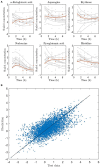Data-driven analysis and prediction of dynamic postprandial metabolic response to multiple dietary challenges using dynamic mode decomposition
- PMID: 38357465
- PMCID: PMC10865386
- DOI: 10.3389/fnut.2023.1304540
Data-driven analysis and prediction of dynamic postprandial metabolic response to multiple dietary challenges using dynamic mode decomposition
Abstract
Motivation: In the field of precision nutrition, predicting metabolic response to diet and identifying groups of differential responders are two highly desirable steps toward developing tailored dietary strategies. However, data analysis tools are currently lacking, especially for complex settings such as crossover studies with repeated measures.Current methods of analysis often rely on matrix or tensor decompositions, which are well suited for identifying differential responders but lacking in predictive power, or on dynamical systems modeling, which may be used for prediction but typically requires detailed mechanistic knowledge of the system under study. To remedy these shortcomings, we explored dynamic mode decomposition (DMD), which is a recent, data-driven method for deriving low-rank linear dynamical systems from high dimensional data.Combining the two recent developments "parametric DMD" (pDMD) and "DMD with control" (DMDc) enabled us to (i) integrate multiple dietary challenges, (ii) predict the dynamic response in all measured metabolites to new diets from only the metabolite baseline and dietary input, and (iii) identify inter-individual metabolic differences, i.e., metabotypes. To our knowledge, this is the first time DMD has been applied to analyze time-resolved metabolomics data.
Results: We demonstrate the potential of pDMDc in a crossover study setting. We could predict the metabolite response to unseen dietary exposures on both measured (R2 = 0.40) and simulated data of increasing size (= 0.65), as well as recover clusters of dynamic metabolite responses. We conclude that this method has potential for applications in personalized nutrition and could be useful in guiding metabolite response to target levels.
Availability and implementation: The measured data analyzed in this study can be provided upon reasonable request. The simulated data along with a MATLAB implementation of pDMDc is available at https://github.com/FraunhoferChalmersCentre/pDMDc.
Keywords: differential responders; dynamic mode decomposition; metabotypes; personalized nutrition; precision nutrition.
Copyright © 2024 Skantze, Jirstrand, Brunius, Sandberg, Landberg and Wallman.
Conflict of interest statement
The authors declare that the research was conducted in the absence of any commercial or financial relationships that could be construed as a potential conflict of interest. The author(s) declared that they were an editorial board member of Frontiers, at the time of submission. This had no impact on the peer review process and the final decision.
Figures








Similar articles
-
Data-driven modeling and prediction of blood glucose dynamics: Machine learning applications in type 1 diabetes.Artif Intell Med. 2019 Jul;98:109-134. doi: 10.1016/j.artmed.2019.07.007. Epub 2019 Jul 26. Artif Intell Med. 2019. PMID: 31383477 Review.
-
Dynamic-mode decomposition and optimal prediction.Phys Rev E. 2021 Jan;103(1-1):012201. doi: 10.1103/PhysRevE.103.012201. Phys Rev E. 2021. PMID: 33601499
-
Koopman Invariant Subspaces and Finite Linear Representations of Nonlinear Dynamical Systems for Control.PLoS One. 2016 Feb 26;11(2):e0150171. doi: 10.1371/journal.pone.0150171. eCollection 2016. PLoS One. 2016. PMID: 26919740 Free PMC article.
-
Dynamic patterns of postprandial metabolic responses to three dietary challenges.Front Nutr. 2022 Sep 22;9:933526. doi: 10.3389/fnut.2022.933526. eCollection 2022. Front Nutr. 2022. PMID: 36211489 Free PMC article.
-
Metabotyping for Precision Nutrition and Weight Management: Hype or Hope?Curr Nutr Rep. 2022 Jun;11(2):117-123. doi: 10.1007/s13668-021-00392-y. Epub 2022 Jan 13. Curr Nutr Rep. 2022. PMID: 35025088 Review.
Cited by
-
Recent advances in precision nutrition and cardiometabolic diseases.Rev Esp Cardiol (Engl Ed). 2025 Mar;78(3):263-271. doi: 10.1016/j.rec.2024.09.003. Epub 2024 Sep 30. Rev Esp Cardiol (Engl Ed). 2025. PMID: 39357800 Free PMC article. Review.
References
-
- Nicholson JK, Holmes E. Global systems biology and personalized healthcare solutions. Discov Med. (2006) 6:63–70. PMID: - PubMed
LinkOut - more resources
Full Text Sources

